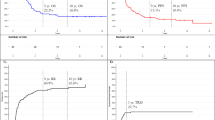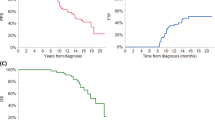Abstract
Auto-SCT is an effective therapy for patients with multiple myeloma (MM), but nearly a fifth of these patients relapse within a year of auto-SCT. We studied 494 patients, undergoing auto-SCT within 12 months of diagnosis of MM. Patients were divided into two groups: early relapse (relapse ⩽12 months from auto-SCT) and late relapse (either relapsed >12 months after auto-SCT or disease free at the last follow up). One hundred twenty patients (24%) were in the early relapse and 374 (76%) were in the late-relapse groups. The early relapse group had a significantly shorter median overall survival (OS) from diagnosis (26.6 vs 90.7 months; P<0.001) and from auto-SCT (20.1 vs 82.5 months; P<0.001). Among the 345 patients who have relapsed after auto-SCT, median OS from relapse was 10.8 months in the early relapse group compared to 41.8 months for the rest (P<0.001) and was longer with increasing duration of response to the SCT. In multivariate analyses, labeling index ⩾1% at transplant, greater than one treatment regimen prior to auto-SCT, and failure to achieve a complete response were predictive of early relapse. Patients who relapse within 12 months of an auto-SCT have a poor outcome and should be offered trials evaluating novel treatment approaches.
This is a preview of subscription content, access via your institution
Access options
Subscribe to this journal
Receive 12 print issues and online access
$259.00 per year
only $21.58 per issue
Buy this article
- Purchase on Springer Link
- Instant access to full article PDF
Prices may be subject to local taxes which are calculated during checkout



Similar content being viewed by others
References
Bataille R, Harousseau JL . Multiple myeloma. N Engl J Med 1997; 336: 1657–1664.
Jemal A, Siegel R, Ward E, Murray T, Xu J, Smigal C et al. Cancer statistics, 2006. CA Cancer J Clin 2006; 56: 106–130.
Alexanian R, Bonnet J, Gehan E, Haut A, Hewlett J, Lane M et al. Combination chemotherapy for multiple myeloma. Cancer 1972; 30: 382–389.
Combination chemotherapy versus melphalan plus prednisone as treatment for multiple myeloma: an overview of 6,633 patients from 27 randomized trials. Myeloma Trialists’ Collaborative Group. J Clin Oncol 1998; 16: 3832–3842.
Attal M, Harousseau JL, Stoppa AM, Sotto JJ, Fuzibet JG, Rossi JF et al. A prospective, randomized trial of autologous bone marrow transplantation and chemotherapy in multiple myeloma. Intergroupe Francais du Myelome. N Engl J Med 1996; 335: 91–97.
Child JA, Morgan GJ, Davies FE, Owen RG, Bell SE, Hawkins K et al. High-dose chemotherapy with hematopoietic stem-cell rescue for multiple myeloma. N Engl J Med 2003; 348: 1875–1883.
Fermand JP, Ravaud P, Chevret S, Divine M, Leblond V, Belanger C et al. High-dose therapy and autologous peripheral blood stem cell transplantation in multiple myeloma: up-front or rescue treatment? Results of a multicenter sequential randomized clinical trial. Blood 1998; 92: 3131–3136.
Barlogie B, Kyle RA, Anderson KC, Greipp PR, Lazarus HM, Hurd DD et al. Standard chemotherapy compared with high-dose chemoradiotherapy for multiple myeloma: final results of phase III US Intergroup Trial S9321. J Clin Oncol 2006; 24: 929–936.
Fermand JP, Katsahian S, Divine M, Leblond V, Dreyfus F, Macro M et al. High-dose therapy and autologous blood stem-cell transplantation compared with conventional treatment in myeloma patients aged 55 to 65 years: long-term results of a randomized control trial from the Group Myelome-Autogreffe. J Clin Oncol 2005; 23: 9227–9233.
Blade J, Rosinol L, Sureda A, Ribera JM, Diaz-Mediavilla J, Garcia-Larana J et al. High-dose therapy intensification compared with continued standard chemotherapy in multiple myeloma patients responding to the initial chemotherapy: long-term results from a prospective randomized trial from the Spanish cooperative group PETHEMA. Blood 2005; 106: 3755–3759.
Rajkumar SV, Blood E, Vesole D, Fonseca R, Greipp PR . Phase III clinical trial of thalidomide plus dexamethasone compared with dexamethasone alone in newly diagnosed multiple myeloma: a clinical trial coordinated by the Eastern Cooperative Oncology Group. J Clin Oncol 2006; 24: 431–436.
Jagannath S, Durie BG, Wolf J, Camacho E, Irwin D, Lutzky J et al. Bortezomib therapy alone and in combination with dexamethasone for previously untreated symptomatic multiple myeloma. Br J Haematol 2005; 129: 776–783.
Lacy MQ, Gertz MA, Dispenzieri A, Hayman SR, Geyer S, Kabat B et al. Long-term results of response to therapy, time to progression, and survival with lenalidomide plus dexamethasone in newly diagnosed myeloma. Mayo Clin Proc 2007; 82: 1179–1184.
Harousseau JL, Attal M, Leleu X, Troncy J, Pegourie B, Stoppa AM et al. Bortezomib plus dexamethasone as induction treatment prior to autologous stem cell transplantation in patients with newly diagnosed multiple myeloma: results of an IFM phase II study. Haematologica 2006; 91: 1498–1505.
Avet-Loiseau H, Attal M, Moreau P, Charbonnel C, Garban F, Hulin C et al. Genetic abnormalities and survival in multiple myeloma: the experience of the Intergroupe Francophone du Myelome. Blood 2007; 109: 3489–3495.
Gertz MA, Lacy MQ, Dispenzieri A, Greipp PR, Litzow MR, Henderson KJ et al. Clinical implications of t(11;14)(q13;q32), t(4;14)(p16.3;q32), and -17p13 in myeloma patients treated with high-dose therapy. Blood 2005; 106: 2837–2840.
Greipp PR, San Miguel J, Durie BG, Crowley JJ, Barlogie B, Blade J et al. International staging system for multiple myeloma. J Clin Oncol 2005; 23: 3412–3420.
Moreau P, Robillard N, Avet-Loiseau H, Pineau D, Morineau N, Milpied N et al. Patients with CD45 negative multiple myeloma receiving high-dose therapy have a shorter survival than those with CD45 positive multiple myeloma. Haematologica 2004; 89: 547–551.
Barlogie B, Smith L, Alexanian R . Effective treatment of advanced multiple myeloma refractory to alkylating agents. N Engl J Med 1984; 310: 1353–1356.
Greipp PR, Lust JA, O’Fallon WM, Katzmann JA, Witzig TE, Kyle RA . Plasma cell labeling index and beta 2-microglobulin predict survival independent of thymidine kinase and C-reactive protein in multiple myeloma. Blood 1993; 81: 3382–3387.
Kaplan E, Meier P . Non-parametric estimation from incomplete observations. J Am Stat Assoc 1958; 53: 457–481.
Cox D . Regression models and life tables. J R Stat Soc 1972; 34: 187–202.
Fonseca R, Barlogie B, Bataille R, Bastard C, Bergsagel PL, Chesi M et al. Genetics and cytogenetics of multiple myeloma: a workshop report. Cancer Res 2004; 64: 1546–1558.
Stewart AK, Bergsagel PL, Greipp PR, Dispenzieri A, Gertz MA, Hayman SR et al. A practical guide to defining high-risk myeloma for clinical trials, patient counseling and choice of therapy. Leukemia 2007; 21: 529–534.
Moreau P, Facon T, Leleu X, Morineau N, Huyghe P, Harousseau JL et al. Recurrent 14q32 translocations determine the prognosis of multiple myeloma, especially in patients receiving intensive chemotherapy. Blood 2002; 100: 1579–1583.
Shaughnessy Jr JD, Barlogie B . Using genomics to identify high-risk myeloma after autologous stem cell transplantation. Biol Blood Marrow Transplant 2006; 12: 77–80.
Rajkumar S, Fonseca R, Lacy M, Witzig T, Lust J, Greipp P et al. Abnormal cytogenetics predict poor survival after high-dose therapy and autologous blood cell transplantation in multiple myeloma. Bone Marrow Transplant 1999; 24: 497–503.
Rajkumar SV, Fonseca R, Dispenzieri A, Lacy MQ, Witzig TE, Lust JA et al. Effect of complete response on outcome following autologous stem cell transplantation for myeloma. Bone Marrow Transplant 2000; 26: 979–983.
Rajkumar SV, Fonseca R, Lacy MQ, Witzig TE, Lust JA, Greipp PR et al. Beta2-microglobulin and bone marrow plasma cell involvement predict complete responders among patients undergoing blood cell transplantation for myeloma. Bone Marrow Transplant 1999; 23: 1261–1266.
Rajkumar SV, Fonseca R, Lacy MQ, Witzig TE, Therneau TM, Kyle RA et al. Plasmablastic morphology is an independent predictor of poor survival after autologous stem-cell transplantation for multiple myeloma. J Clin Oncol 1999; 17: 1551–1557.
Moreau P, Attal M, Garban F, Hulin C, Facon T, Marit G et al. Heterogeneity of t(4;14) in multiple myeloma. Long-term follow-up of 100 cases treated with tandem transplantation in IFM99 trials. Leukemia 2007; 21: 2020–2024.
Alvares CL, Davies FE, Horton C, Patel G, Powles R, Morgan GJ . The role of second autografts in the management of myeloma at first relapse. Haematologica 2006; 91: 141–142.
Lenhoff S, Hjorth M, Turesson I, Westin J, Gimsing P, Wisloff F et al. Intensive therapy for multiple myeloma in patients younger than 60 years. Long-term results focusing on the effect of the degree of response on survival and relapse pattern after transplantation. Haematologica 2006; 91: 1228–1233.
Mehta J, Singhal S . High-dose chemotherapy and autologous hematopoietic stem cell transplantation in myeloma patients under the age of 65 years. Bone Marrow Transplant 2007; 40: 1101–1114.
Kumar S, Blade J, Miguel JS, Hajek R, Nagler A, Sonneveld P et al. Pegylated liposomal doxorubicin (PLD) in combination with bortezomib (B) may provide therapeutic advantage for high-risk multiple myeloma patients relapsing within 12 months of stem cell transplant. ASH Annual Meeting Abstracts 2007; 110: 2730.
Garban F, Attal M, Michallet M, Hulin C, Bourhis JH, Yakoub-Agha I et al. Prospective comparison of autologous stem cell transplantation followed by dose-reduced allograft (IFM99-03 trial) with tandem autologous stem cell transplantation (IFM99-04 trial) in high-risk de novo multiple myeloma. Blood 2006; 107: 3474–3480.
Bruno B, Rotta M, Patriarca F, Mordini N, Allione B, Carnevale-Schianca F et al. A comparison of allografting with autografting for newly diagnosed myeloma. N Engl J Med 2007; 356: 1110–1120.
Kumar S, Lacy MQ, Dispenzieri A, Rajkumar SV, Fonseca R, Geyer S et al. High-dose therapy and autologous stem cell transplantation for multiple myeloma poorly responsive to initial therapy. Bone Marrow Transplant 2004; 34: 161–167.
Blade J, Rosinol L, Garcia-Sanz R, Lahuerta J, Hernandez M, Sureda A et al. A PETHEMA study of high-dose therapy/stem cell support (HDT), including tandem transplant, in primary refractory multiple myeloma (MM): Identification of two populations with different outcomes. J Clin Oncol (Meeting Abstracts) 2007; 25: 8021.
Abdelkefi A, Ladeb S, Torjman L, Ben Othman T, Lakhal A, Ben Romdhane N et al. Single autologous stem cell transplantation followed by maintenance therapy with thalidomide is superior to double autologous transplantation in multiple myeloma: results of a multicenter randomized clinical trial. Blood 2007; 111: 1805–1810.
Attal M, Harousseau JL, Facon T, Guilhot F, Doyen C, Fuzibet JG ; et al. Single versus double autologous stem-cell transplantation for multiple myeloma. N Engl J Med 2003; 349: 2495–2502.
Acknowledgements
SK was involved in design of concept, data collection, analysis and writing the paper, STM, AD, MQL, SRH, FKB, DD, SVR, MRL and MAG were involved in writing the manuscript. This study was supported in part by Hematologic Malignancies Program, Mayo Clinic CR20 program, ASCO Young Investigator Award and Amgen Oncology Institute Junior Faculty Award (SK). It was presented in part at American Society of Clinical Oncology annual meeting, May 2007.
Author information
Authors and Affiliations
Corresponding author
Rights and permissions
About this article
Cite this article
Kumar, S., Mahmood, S., Lacy, M. et al. Impact of early relapse after auto-SCT for multiple myeloma. Bone Marrow Transplant 42, 413–420 (2008). https://doi.org/10.1038/bmt.2008.180
Received:
Revised:
Accepted:
Published:
Issue Date:
DOI: https://doi.org/10.1038/bmt.2008.180
Keywords
This article is cited by
-
ML-based sequential analysis to assist selection between VMP and RD for newly diagnosed multiple myeloma
npj Precision Oncology (2023)
-
An early post-transplant relapse prediction score in multiple myeloma: a large cohort study from the chronic malignancies working party of EBMT
Bone Marrow Transplantation (2023)
-
High-risk disease in newly diagnosed multiple myeloma: beyond the R-ISS and IMWG definitions
Blood Cancer Journal (2022)
-
Gaps and opportunities in the treatment of relapsed-refractory multiple myeloma: Consensus recommendations of the NCI Multiple Myeloma Steering Committee
Blood Cancer Journal (2022)
-
Early relapse is an adverse prognostic marker in systemic immunoglobulin light chain (AL) Amyloidosis
Leukemia (2022)



